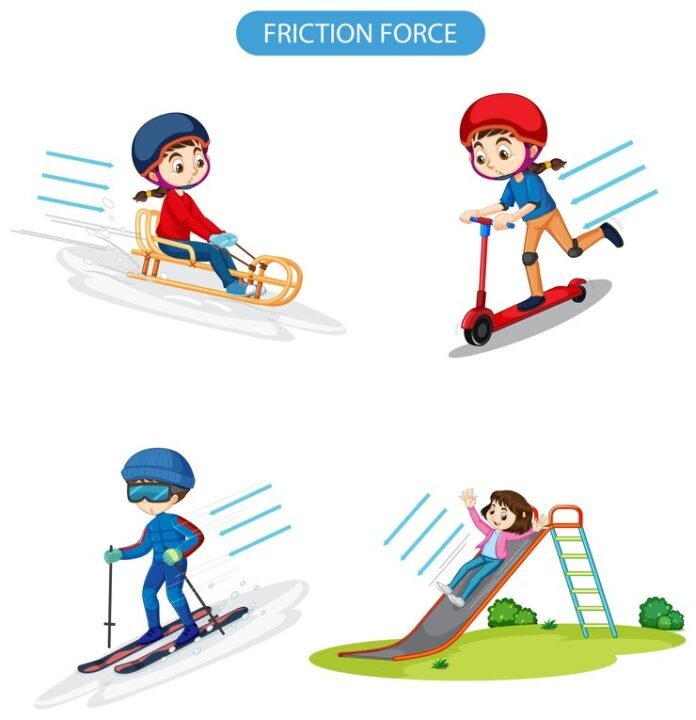Introduction
With two surfaces sliding or attempting to slide over one another, there is a force called friction. For instance, friction makes pushing a book down the floor challenge. Friction always moves an object in a direction counter to the direction it is travelling or attempting to move. A moving object is always slowed down by friction. The two surfaces’ differing materials impact how much friction exists. Friction is increased in direct proportion to surface roughness. Heat is also produced through friction. You can feel your hands warming up if you rub them together rapidly.
Types of Friction
Static, sliding, rolling, and fluid friction are the four main categories of frictional force.
Static friction
Pushing a large box across the floor requires force to combat static friction. The large crate is resting on the ground. As a result, there is static friction here between the surface of the box and the ground when it is at rest. The box begins to slide across the floor when the force we exert exceeds the static friction. There is sliding friction between the box’s surface and the ground.
Sliding friction
Sliding friction is another form of friction. Because just one side of the body is in contact with the surface, there may be a restriction on the body’s ability to move. Friction caused by sliding is an instance of pushing a box over a table.
Fluid friction
We encounter a force that resists our motion in the water while we swim. The water is causing friction with the surface in question. It’s referred to as fluid friction. Liquids, including gases that have been fluids, experience fluid friction.
Rolling friction
We can now see rollers attached to luggage and suitcases. Understand why? This is so that the rollers on the heavy luggage can lessen the force of friction between its surface and the ground as we drag it. Rolling friction is the frictional force between the surface of a suitcase rolling on the ground. A hefty luggage may be rolled considerably more easily than you can slide it across the ground.
Example of Frictional Force
We must use force to overcome the frictional force as we push a stack of books onto a table. The bicycle eventually comes to an end if we stop pedalling. The bicycle comes to a stop as a result of a frictional force among its tyres as well as the ground.
These are a few instances of frictional force that we encounter daily. The frictional force is said to oppose the motion of surfaces in contact, according to the instances of frictional force provided. It is also in charge of stopping a moving object.
Factors Affecting Friction
According to the following causes, the force of friction may change:
- Whenever two smooth surfaces come into touch, there is little interlocking between them and therefore little friction between them.
- Whenever two rough surfaces come into touch, there is a lot of friction between them because there is an excessive amount of interlocking between the rough surfaces.
- It also relies on the object’s weight or how much force the object exerts on the surface.
Advantages of Friction
- Numerous motions are caused by friction.
- It enables us to traverse the terrain.
- To stop a car, brakes utilise friction.
- Friction causes asteroids to burn up in the atmosphere before they reach Earth.
- When we rub our hands together, heat is produced.
Disadvantages of Friction
- Friction wastes energy by making additional heat that is not necessary.
- Friction slows down the velocity of moving things because its force acts in the opposing direction of motion.
- Friction between tree branches is what starts forest fires.
- By adopting methods like greasing and oiling, friction and the typical wear and tear it causes are significantly reduced.
Recommended Articles:
Electrical Generators and Their Types
Types of Levers – Basic Definitions and Examples
Differences Types of Motors
What are the Types of Radiation?
Types of Rocks – Igneous, Sedimentary and Metamorphic
Friction comes in four varieties: flowing, rolling, sliding, and static. Among solid surfaces, there is static, sliding, or rolling friction. The three types of friction are ranked from strongest to weakest: rolling, sliding, and static. Fluid friction happens when liquids and gases are mixed. Friction occurs whenever two items come into contact with one another. Friction acts in the opposite direction from the motion and works against it. The two surfaces' various materials impact how much friction exists. Friction is increased in direct proportion to surface roughness. Friction is a force that prevents two solid objects from rolling or sliding over one another. Although frictional forces, like the traction required to walk without slipping, may be advantageous, they can provide significant resistance to motion. There are two main types of friction that affect a moving solid body: Rolling friction or resistance prevents a rolling body from moving across a surface. Static friction is significantly stronger than rolling friction. A force that holds an object at rest is called static friction. The definition of static friction is: The resistance people feel whenever they attempt to move a stationary object across a surface without actually causing any relative movement between their body and the surface they are moving the object across. Types of Friction FAQs
Which two types of friction are there?
How does friction form?
What is friction?
What is rolling friction?
Rolling friction is demonstrated by a ball or wheel rolling across the ground.
Sliding friction is another form of friction. Because just one side of the body is in contact with the surface, there may be a restriction on the body's ability to move.
Friction caused by sliding is an instance of pushing a box over a table.Explain static friction.
